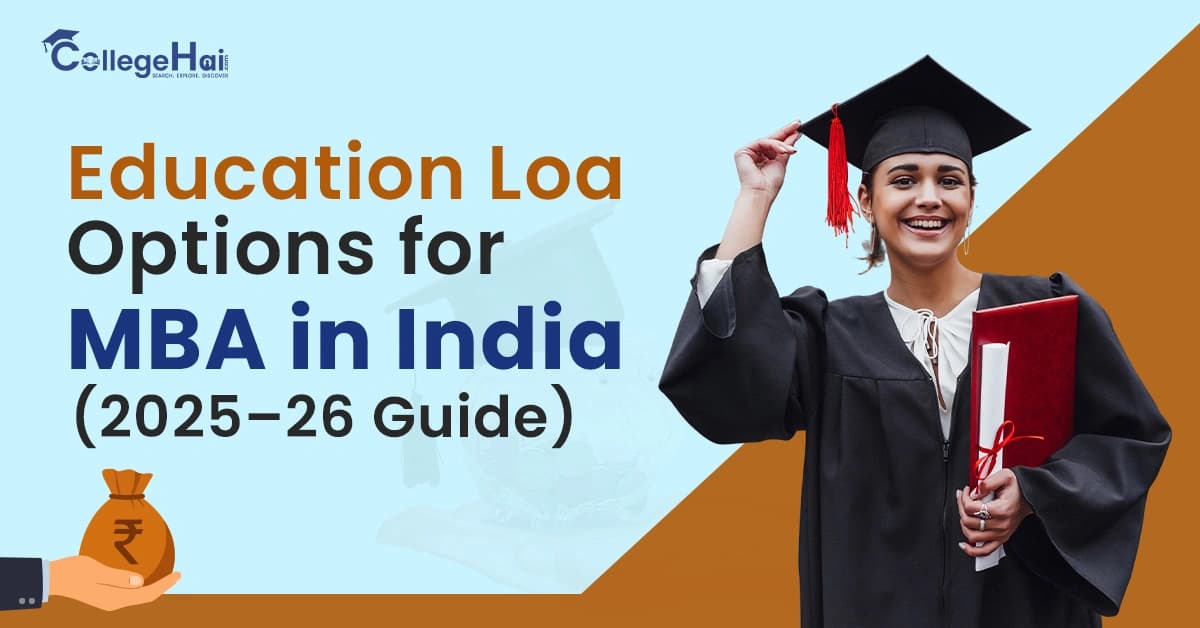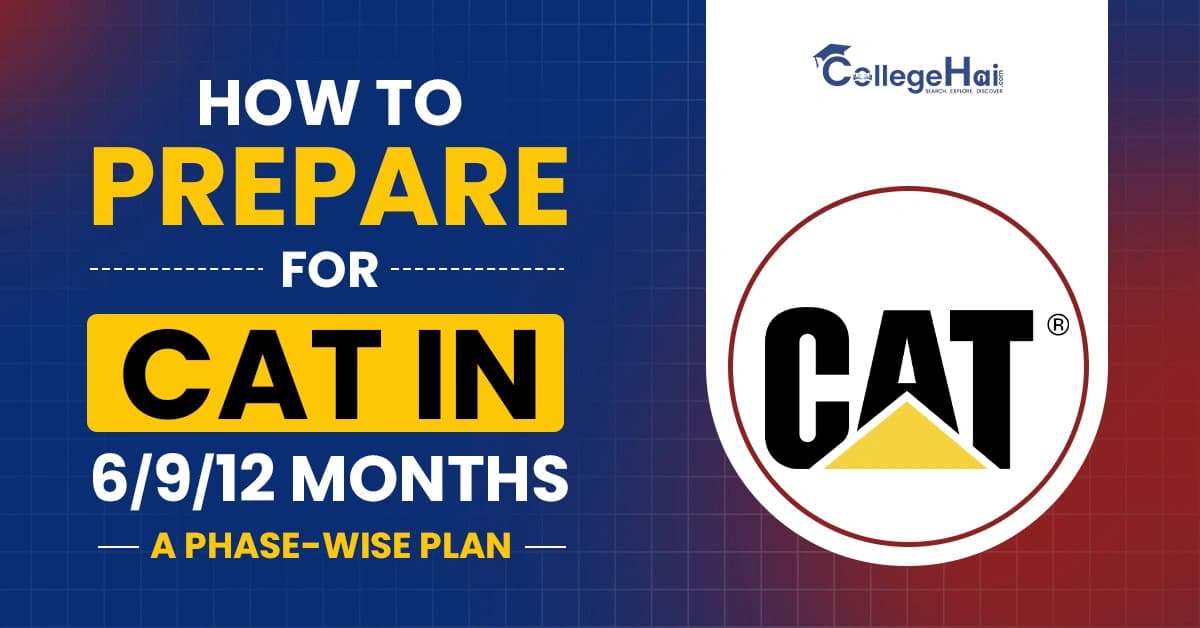The expenses of obtaining an MBA from leading B-schools in India have soared over the years, with costs now at top institutes such as IIM Ahmedabad at INR 34.15 lakhs in 2025, from INR 4.6 lakhs in 2007, an increase of almost eight times. IIM Bangalore and IIM Mumbai also charge high-priced fees of around INR 26 lakh and INR 19 lakh, respectively, thus making it a significant financial expenditure for students.
Annually, there are more than 3.2 lakh students who qualify to sit for the CAT exams. The competition has become fierce and expensive. Managing costs looks daunting, but educational loans have become a terrific lifeline for thousands of MBA aspirants, so they can fuel their dreams without being financially overwhelmed. If you feel confused or stressed about the education loan process or which loan to select, this blog will give you a systematic approach to the whole process. We will make it simple for you, from loan offers to tips for completion, so alleviate stress and get yourself prepared confidently to enter your MBA without financial concerns.
To manage these rising costs, let's first understand the types of education loans that can help you finance your MBA
What are the Types of Education Loans?
If you plan to take out a loan for your MBA, it’s important to understand the two main types of education loans:
Secured Loans - A secured loan requires collateral such as property, fixed deposit (FDs), or government bonds. As the bank has some security for the loan, they are usually able to offer a lower interest rate and a higher amount of money to borrow.
Unsecured Loans - An unsecured loan is based simply on your eligibility without the need for collateral. However, the tradeoff here is that it usually comes with a much higher interest rate and stricter eligibility parameters.
Which Banks Offer Education Loans for MBA?

Are you searching for the ideal education loan? Below is an overview to clarify what some recognised banks have to offer. For example, the State Bank of India can lend you up to INR 30 lakhs for studies at any one of the top institutes, at an interest rate ranging from 7.15% to 10.15%. For female applicants, there is also a concession of a 0.5% rate cut! The repayment period is up to 15 years from the time you start repaying after 6 months post your course.
Bank of Baroda offers an even bigger amount of up to INR 150 lakhs at a higher interest rate of 10.15% to 10.70%. It is worth noting that they also provide students from top schools and the female concession of 0.5%. The maximum repayment time is also 15 years after an initial grace period.
Whereas, the Canara Bank provides an interest rate of 8.25% and a maximum of INR 100 lakhs as the loan amount. Their repayment period is between 3 to 7 years, but can go to 15 years depending on the student plan. The HDFC Bank can provide an education loan of INR 10 lakhs to 150 lakhs and has a rate of up to 10.50%. The repayment period is 15 years. Finally, Bank of India also provides an educational loan of INR 150 lakhs with an interest rate of approximtely 10.65%-10.85% and they also have a 0.5% for female applicants. Their repayment is also 15 years. Overall, these banks do provide some flexible options for you to afford the cost of pursuing your dreams of education.
Implication of This: The various banks may offer different amounts of loans, interest rates, and repayment periods. Some banks may also offer concessions if you are a girl or belong to the SC/ST categories. You should evaluate all the options thoroughly depending on your needs.
Government Support for MBA Education Loans
The Indian government offers students helpful schemes through its platform, like:
Vidya Lakshmi Portal: A one-stop platform or a website for students to compare and apply for education loans from different banks, and to track their application and also look for scholarships.
Central Sector Interest Subsidy Scheme (CSIS): This will help students who are from economically weaker backgrounds by providing the interest amount on the loan moratorium period (the time under which the student is studying).
How to Choose the Best Education Loan for Your MBA?
Applying for a loan can be relatively simple and the repayment thereof can be relatively frustrating if you aren't careful. The borrower should either ask the bank what the effective market rate is, or the borrower should act to secure and understand what the effective market rate is, by asking the bank whether they price their rates on the base rate when they are disclosing their rates to an applicant.
Normally, a lender discloses their base rate and then applies a margin amount to the base rate. So if it is mentioned that the base is 10.25% and the margin was 0.25%, you would pay an effective interest rate (effective market rate) of simply 10.50%. As with all information, you, as the borrower, determine, but it is always prudent to delay drawing reasonable conclusions until the number has been added appropriately, as indicated by the bank. Here are a few suggestions for simplifying your journey
1. Compare Different Bank Offerings
It is particularly important to check the maximum amount you are requesting. For instance, if you need INR 20 lakh, but the bank can only lend you INR 15 lakh, you would have to find the remaining Rs 5 lakh from elsewhere at some additional cost.
2. Choose Banks that Do Not Require a Margin
Some banks will require you to pay a portion of the fee as your margin, which amounts to a deposit. Be sure to look for banks that specifically do not require a margin amount, particularly for large values like INR 20 lakh.
3. Stay Away from Banks that have Processing Fees
Some banks would charge you simply to process your loan application, and will expect that you pay that forward to them as a fee. Generally speaking, public sector banks will waive processing fees, or simply do not charge processing fees and charge no fees at all to a deserving applicant.
4. Understand the Interest Rate Structure
For illustrative purposes, if the bank discloses a "base rate" of 10.25% and a margin of 0.25%, your effective interest rate would equal 10.50%. Use caution if the bank reads rates that way! They don't mean for the borrower to simply read the numbers.
What are the Eligibility Criteria for an MBA Education Loan?
In most cases, to take an MBA education loan in India, you will need to:
Achieve at least a 60% in your Bachelor’s.
Have continuous education (no big gaps unless justified).
Secure a co-signer (usually a parent) with a credit score of 700 or higher.
Have a medical certificate if a break in studies was due to medical reasons.
Some state banks may require the borrower to be under 35.
Documents You’ll Need to Apply
When applying for an education loan, prepare the following documents to be provided in an online format:
Educational certificates from the 10th standard to the latest qualification
Valid KYC documents like PAN card, Aadhaar, Passport or Voter ID
Proof of residency like an electricity bill, Aadhaar, ration card, etc
Last 6 months' bank statements of the co-applicant
Income tax returns of the co-applicant for the last 2 years
How to Apply for Your MBA Education Loan in 2025
Here’s a straightforward breakdown of the process that you can follow:
Do your research and compare lenders in terms of interest, repayment options, and moratorium.
You will need to check the eligibility of your academic and financial profiles.
It is best to get all the documentation together in advance.
You can apply online or in person at a bank branch.
The bank will verify your documentation and capacity to repay the loan.
If you are approved, the amount will be sent directly to your college or institution.
Lastly, apply early to avoid a last-minute rush!
Conclusion
The soaring fee structure of premier Indian MBA programs presents serious problems for many prospective students; however, student loans offer a reasonable and practical option to address this funding gap. Knowing the types of loans, eligibility criteria, and government policies to support you can help you make choices that are right for you. Comparing banks with respect to caps on loans, restrictions, interest rates, repayment terms, and concessions will give you the best option to minimise costs while both maximising the utility of the loan for your situation and avoiding complications.
Planning and applying on time uses the best authority for these loans. Once you have planned appropriately, financing your MBA is much easier and allows you to focus on starting a successful career without as much concern about the aspects of money for school. Approaching the funding this way can help you feel comfortable taking the next step to explore your MBA options and receive the maximum benefit the time and investment of education will offer by going to a prestigious program.
About the Author

Content Writer



